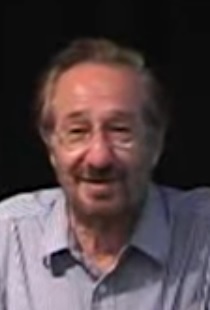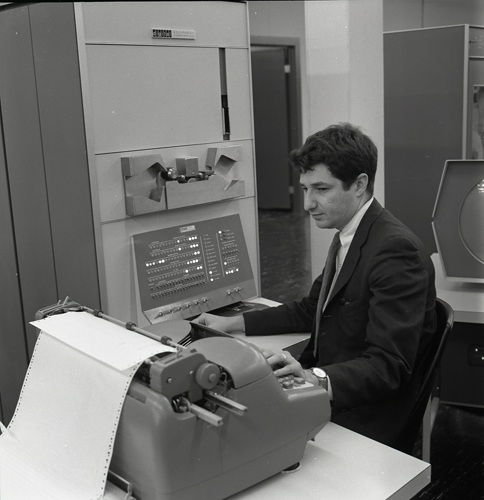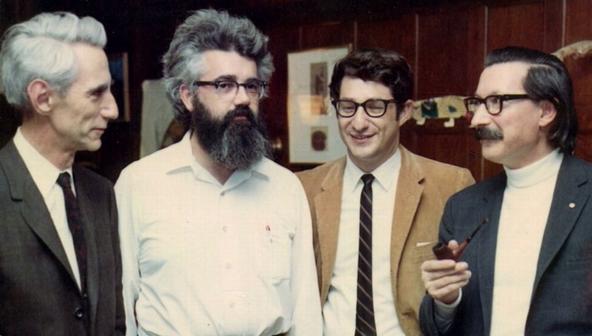Edward Fredkin
Home * People * Edward Fredkin

Edward (Ed) Fredkin, (born 1934)
an American physicist, computer scientist, pioneer of digital physics and advocate of digital philosophy. He was full professor at Massachusetts Institute of Technology, from 1971 to 1974 Director of Project MAC and more recently a Distinguished Career Professor at Carnegie Mellon University, at Boston University and a Visiting Professor at MIT.
Fredkin has been broadly interested in computation, hardware as well as software. In the early 1960s, he wrote the first PDP-1 assembler at BBN. He is inventor of the trie data structure [2], the Fredkin gate and the Billiard-Ball Computer Model for reversible computing. His primary contributions include his work on reversible computing and cellular automaton. While Konrad Zuse's book, Calculating Space, mentioned the importance of reversible computation, the Fredkin gate represented the essential breakthrough [3]. He has further been involved in computer vision, artificial intelligence research, and computer chess. Ed Fredkin instrumented the original conception and hardware design of the Chess-orientated Processing System CHEOPS, which was used by Baisley's Tech 2 and a brute force version of Greenblatt's Mac Hack at the end of the 70s [4].
Contents
Photos
Ed Fredkin working on PDP-1 (1960 ca.) [5]
Claude Shannon, John McCarthy, Ed Fredkin and Joseph Weizenbaum (1966) [6]
The Fredkin Prize
In 1980, Carnegie Mellon University has announced the establishment of a $100,000 prize for the first computer program to become World Chess Champion and the beginning of annual computer versus human competition. The prize called Fredkin Prize, has been established by the Fredkin Foundation of Cambridge, Massachusetts [7], to encourage continued research progress in computer chess. The prize was three-tiered [8]:
- The first award of $5,000 was given to Ken Thompson and Joe Condon from Bell Laboratories, who in 1981 developed the first chess machine to achieve master status.
- Seven years later, the intermediate prize of $10,000 for the first chess machine to reach international master status was awarded in 1989 to five Carnegie Mellon graduate students who built Deep Thought, the precursor to Deep Blue, at the university.
- The $100,000 third tier of the prize was awarded at AAAI-97 to this IBM team, who built the first computer chess machine that beat a world chess champion.
Teams honored at AAAI-97
- Mac Hack 6, developed by Richard Greenblatt at the Massachusetts Institute of Technology, was the first computer program to play in a human chess tournament. It was the first program to play and win in a tournament game in 1967.
- The Northwestern University computer chess program, developed by David Slate and Larry Atkin from the 1960s to the early 1980s, won several computer chess championships during the 1970s, including the computer world championship in 1977.
- Belle, developed by Ken Thompson and Joe Condon at Bell Labs, was the first chess program to obtain the United States Chess Federation Master title in 1983. It was awarded the first Fredkin Prize of $5,000 for this achievement.
- HiTech, developed at Carnegie Mellon by Hans Berliner, Carl Ebeling, Murray Campbell and Gordon Goetsch, was the first system to achieve a Senior Master’s level of performance in 1988.
- Deep Thought, developed at Carnegie Mellon by Thomas Anantharaman, Murray Campbell, Feng-hsiung Hsu, Andreas Nowatzyk and Mike Browne, was the first system to play at the Grandmaster level. Deep Thought was awarded the $10,000 Fredkin Intermediate Prize for this achievement in 1989 [10].
- Deep Blue, a parallel supercomputer that processes an average of 200 million chess positions per second, is the first chess machine to draw and beat a world chess champion in a regulation game, and the first chess machine to beat the world champion in a regulation match.
Quotes
“There has never been any doubt in my mind that a computer would ultimately beat a reigning world chess champion,” said Fredkin. “The question has always been when.”
Selected Publications
1960 ...
- Edward Fredkin (1960). Trie Memory. Communications of the ACM, Vol. 3, No. 9
- Edward Fredkin, Tommaso Toffoli (1978). Design principles for achieving high-performance submicron digital technologies. Proposal to DARPA, MIT Laboratory for Computer Science.
1980 ...
- Edward Fredkin, Tommaso Toffoli (1982). Conservative logic. International Journal of Theoretical Physics, Vol. 21, on Fredkin gate and Toffoli gate, pdf
- Robert Wright (1989). Three Scientists and Their Gods: Looking for Meaning in an Age of Information. HarperCollins, ISBN 0-06-097257-2, amazon.com, profiles of Edward Fredkin, Edward O. Wilson, and Kenneth Boulding
- Edward Fredkin (1990). Digital Mechanics - An Informational Process Based on Reversible Universal Cellular Automata. Department of Physics, Boston University
- Edward Fredkin (1992). A New Cosmogony. Department of Physics, Boston University
- Edward Fredkin (1992). Finite Nature. Department of Physics, Boston University
2000 ...
- Edward Fredkin (2000). On the Soul. (2000 Draft)
- Edward Fredkin (2004). Five big questions with pretty simple answers. IBM Journal of Research and Development, Vol. 48, No. 1
- Pamela McCorduck (2004). Machines Who Think: A Personal Inquiry into the History and Prospects of Artificial Intelligence. A. K. Peters (25th anniversary edition)
- Edward Fredkin (2005). A computing architecture for physics. 2nd Conference on Computing Frontiers
- Daniel B. Miller, Edward Fredkin (2005). Two-state, Reversible, Universal Cellular Automata in Three Dimensions. 2nd Conference on Computing Frontiers
External Links
- Edward Fredkin from Wikipedia
- Fredkin finite nature hypothesis from Wikipedia
- Edward Fredkin The Computer History Museum
- Edward Fredkin Biography
- Edward Fredkin | LinkedIn
- Edward Fredkin - Google Scholar Citations
- Edward Fredkin (@edfredkin) | Twitter
- Links & Resources in Philosophy & Physics
- Digital Philosophy.org > Home
- The Mouse That Roared: PDP-1 Celebration Event Lecture, May 15, 2006 (1:53:44) Mountain View, CA, USA: © 2006, The Computer History Museum. Panel discussion including Alan Kotok (53:50) and John McCarthy (1:27:20), moderated by Edward Fredkin from 17:40, YouTube Video
References
- ↑ Capture from the PDP-1 Celebration Event Lecture 2006 @18:02, The Computer History Museum
- ↑ Edward Fredkin (1960). Trie Memory. Communications of the ACM, Vol. 3, No. 9
- ↑ Edward Fredkin from Wikipedia
- ↑ John Moussouris, Jack Holloway, Richard Greenblatt (1979). CHEOPS: A Chess-orientated Processing System. Machine Intelligence 9, reprinted (1988) in Computer Chess Compendium
- ↑ Ed Fredkin working on PDP-1 (1960 ca.), from The Computer History Museum
- ↑ Weizenbaum. Rebel at Work. A documentary by Peter Haas and Silvia Holzinger
- ↑ Ben Mittman (1980). $100,000 Prize Established. ICCA Newsletter, Vol. 3, No. 1
- ↑ Carol McKenna Hamilton, Sara Hedberg (1997). Modern Masters of an Ancient Game. AI Magazine, Vol. 18, No. 4, pdf
- ↑ Sara Hedberg (1997). AAAI-97 Highlights - Developments in the AI Field. AI Magazine, Vol. 18, No. 4, pdf
- ↑ Hans Berliner (1989). Deep Thought Wins Fredkin Intermediate Prize. AI Magazine, Vol. 10, No. 2, pdf
- ↑ Digital Philosophy - Documents
- ↑ dblp: Edward Fredkin

